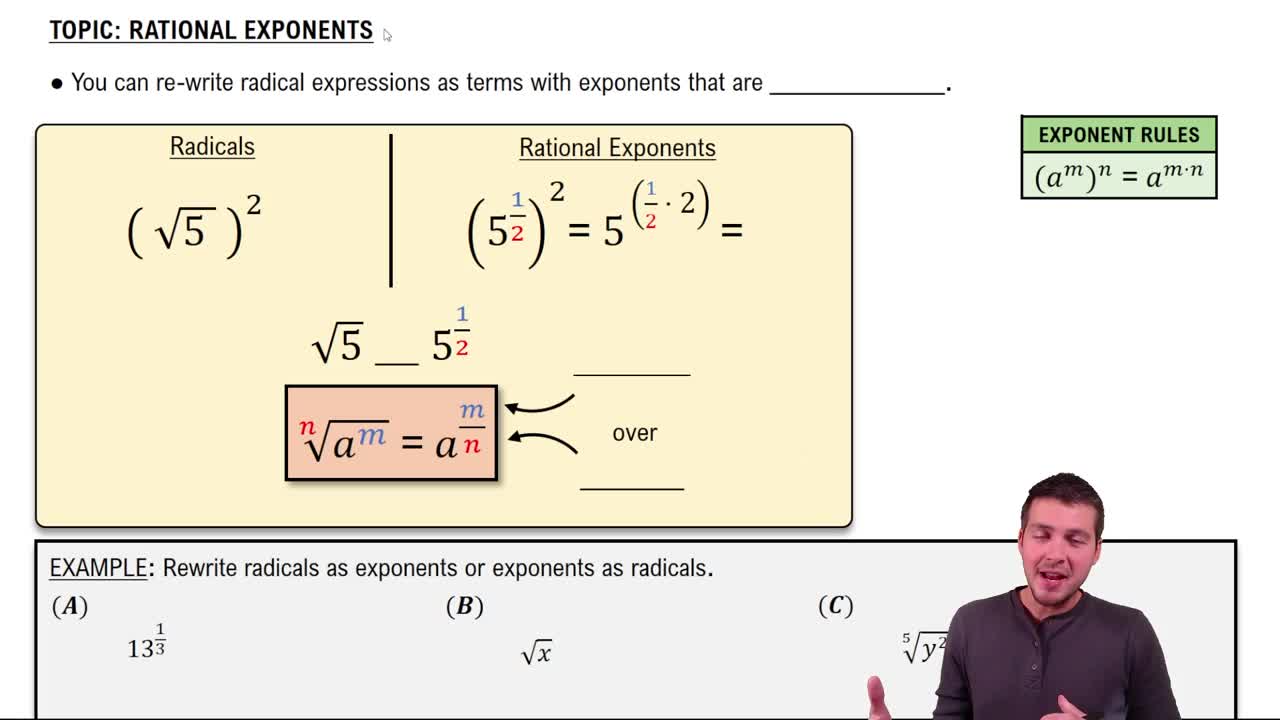Table of contents
- 0. Review of Algebra4h 16m
- 1. Equations & Inequalities3h 18m
- 2. Graphs of Equations43m
- 3. Functions2h 17m
- 4. Polynomial Functions1h 44m
- 5. Rational Functions1h 23m
- 6. Exponential & Logarithmic Functions2h 28m
- 7. Systems of Equations & Matrices4h 6m
- 8. Conic Sections2h 23m
- 9. Sequences, Series, & Induction1h 19m
- 10. Combinatorics & Probability1h 45m
0. Review of Algebra
Radical Expressions
Problem 46c
Textbook Question
Solve: 2x^(2/3) - 5x^(1/3)-3 = 0.
 Verified step by step guidance
Verified step by step guidance1
Let us start by making a substitution to simplify the equation. Set \( y = x^{1/3} \). This means \( y^2 = (x^{1/3})^2 = x^{2/3} \).
Substitute \( y \) and \( y^2 \) into the equation: \( 2y^2 - 5y - 3 = 0 \).
Now, we have a quadratic equation in terms of \( y \). We can solve this quadratic equation using the quadratic formula: \( y = \frac{-b \pm \sqrt{b^2 - 4ac}}{2a} \), where \( a = 2 \), \( b = -5 \), and \( c = -3 \).
Calculate the discriminant \( b^2 - 4ac \) to determine the nature of the roots.
Once you find the values of \( y \), substitute back \( y = x^{1/3} \) to find the corresponding values of \( x \) by solving \( x = y^3 \).
Recommended similar problem, with video answer:
 Verified Solution
Verified SolutionThis video solution was recommended by our tutors as helpful for the problem above
Video duration:
3mPlay a video:
Was this helpful?
Key Concepts
Here are the essential concepts you must grasp in order to answer the question correctly.
Rational Exponents
Rational exponents are a way to express roots using fractional powers. For example, x^(1/n) represents the n-th root of x. In the given equation, the terms 2x^(2/3) and -5x^(1/3) utilize rational exponents, which can be rewritten in radical form to facilitate solving the equation.
Recommended video:
Guided course

Rational Exponents
Substitution Method
The substitution method involves replacing a complex expression with a simpler variable to make solving easier. In this case, letting y = x^(1/3) transforms the equation into a quadratic form, allowing for straightforward application of factoring or the quadratic formula to find solutions.
Recommended video:

Choosing a Method to Solve Quadratics
Quadratic Equations
Quadratic equations are polynomial equations of the form ax^2 + bx + c = 0, where a, b, and c are constants. They can be solved using various methods, including factoring, completing the square, or the quadratic formula. Understanding how to manipulate and solve these equations is crucial for finding the roots of the transformed equation in the problem.
Recommended video:

Introduction to Quadratic Equations
Related Videos
Related Practice













